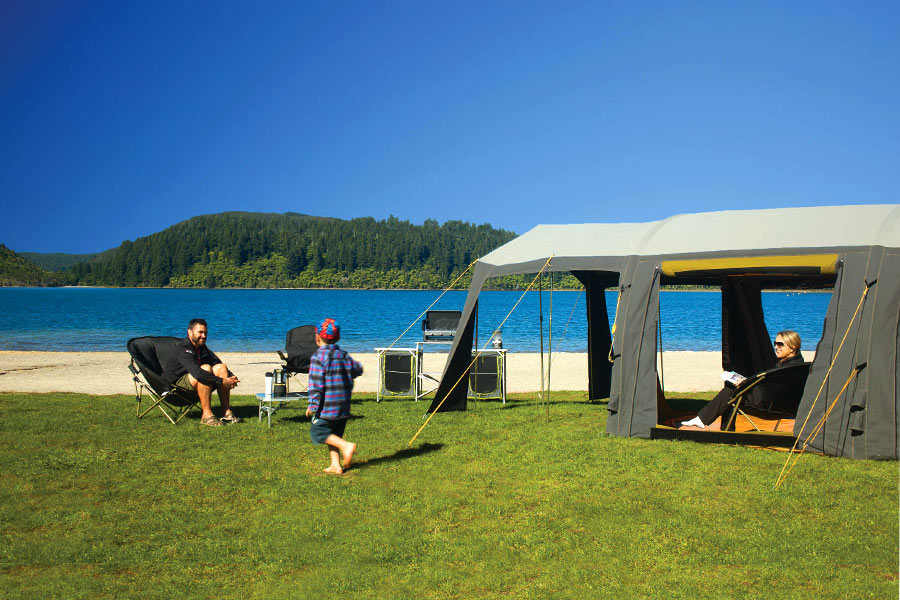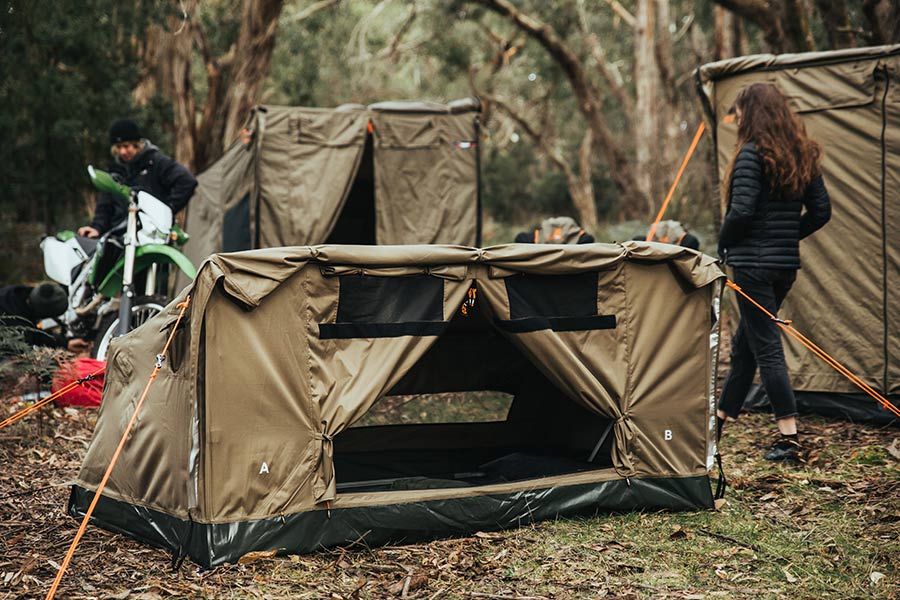Unfortunately, there is no “black and white” answer to tent classification. When it comes to season ratings and tent types, there are a lot of crossovers, and it can become a little confusing when choosing a tent for the first time.
Use this guide to narrow your choice before you get bogged down in small details like the number of rooms, awnings, accessories and fabrics.

Choose a tent can be confusing. Image: Oztent
First, let’s talk about tent seasons
Tents have a season rating, these ratings are not stamped on the tent according to standards or guidelines, they are just a guide.
-
What is a one-season tent?
One season tents are designed to be used in warm or tropical conditions, so they are very breathable and generally won’t be suitable to use in rainy conditions.
-
What is a two-season tent?
Two season tents are designed for spring and autumn use and can withstand light rain and wind.

Some tents are designed to be optimal to use in warm conditions. Image: Sea to Summit
-
What is a three-season tent?
Three season tents are suitable to use during summer, autumn and spring and can withstand moderate wind and rain or very light snow.
-
What is a four-season tent?
Four season tents are suitable for winter use, and can withstand rain, wind and snow, but won’t cover extreme weather conditions.
-
What is an expedition tent?
Expedition tents are suitable for use in extreme weather conditions.

You’ll need a four-season or expedition tent for very cold conditions. Image: Sea to Summit
What season tent will I need for general camping?
For the most part, a three-season tent is suitable for a majority of campers as they offer the most versatility in terms of weather protection and options for ventilation. Family tents are in almost all cases a three-season tent, to cater for a range of weather conditions.
Tent styles and what they’re best used for:
Dome tents
Aptly named on account of their simplistic dome-like appearance, dome tents usually feature two poles that cross diagonally from tent corner to tent corner.
There are variations with extra poles to create storage vestibules and to increase interior space. Some even have ‘quick pitch’ or ‘instant pitch’ frames. But, at the end of the day, they are identified by their characteristic dome shape.

Dome tents come in different variations. Image: Coleman Australia
Quick pitch touring tents
With the daily set-up and pack-down routine of touring holidays, comes the need for tents that pitch and pack away easily and quickly.
Touring tents generally feature an all-in-one design that incorporates an inner attached to a frame that snaps, clicks, locks or extends easily into place, leaving you with just a few pegs and guy ropes to deal with.
There are many types of tents in this category, utilising both heavy-duty canvas and lightweight materials. They are usually more ‘boxy’ in appearance than dome tents. But their main point of identification is their ‘quick pitch’ all-in-one construction.

For those setting up shelter every night, a touring tent is ideal. Image: Snowys Outdoors
Family tents
The biggest selling category for Snowys, and whilst some touring tents can also be labelled family tents, these are generally quite affordable and feature room dividers, large vestibules and often extendable awnings to create a comfortable living space for family holidays.
Pole structures vary from large dome-style configurations to various designs normally utilising flexible fibreglass poles.

Family tents are usually a larger dome style. Image: Coleman Australia
Cabin tents
Big and heavy yet spacious and sturdy, cabin tents are usually made of heavy-duty materials, feature strong steel frames, and have, as its name suggests, a cabin-like appearance with multiple rooms and living spaces.
Cabin tents are most suited to long stays in caravan parks and family-friendly campsites. They offer roomy and comfortable living areas, almost like a mini house.

Big canvas tents are heavier and bulkier, but extremely spacious. Image: Zempire
Hiking tents and bivvies
Weight and pack size are important here, a hiking tent needs to fit into a rucksack, bike pannier or kayak and weigh in at around 2kg or less. They usually offer enough space for 1-2 people plus a little bit of gear.
This category is where season ratings are most relevant. This is because they’re used as a primary source of shelter in areas of weather extremes.
A bivvy bag is an ultra-lightweight one-person shelter, often carried for emergency protection. They are simply a waterproof sack that one user can crawl in to stay dry when caught out in unexpected weather changes.
Often used for mountaineering where climbers sleep on exposed ledges too small for tents.

Hiking tents are compact and ultralight. Image: MSR
Swags and stretcher tents
The humble swag, an image of which has represented camping and the outdoors for hundreds of years, is one of the most popular ways to ‘rough it’ in the bush.
Made with canvas, a simple mattress, all rolled up with your bedding inside and secured with a couple of straps, the swag is a no-fuss approach to camping.
Nowadays there are dome swags with features such as poles, multiple entrances, insect mesh and storage pockets. However, the traditional envelope swag is still preferred for those who like to keep it simple.
Recently, some smart cookies came up with the idea of combining a swag with a stretcher and created the stretcher tent.
In a nutshell, these are swags with a metal, folding pole structure that gets you up off the ground. These are popular for campers who want to add a little extra comfort to their swag setup.

A swag provides reliable shelter for general camping. Image: Oztent
So, what should you take from this guide?
There is no right or wrong when it comes to tent choice, only what’s right for your circumstances.
Common sense prevails in some instances. You won’t want to take a cabin tent on an expedition to Patagonia for instance. At the end of the day, your tent choice comes down to how, when and where you will be using your shelter, and what is going to achieve your desired outcomes.
How versatile are the tents in your gear stash?
Trekker, surfer, climber, mountain biker, runner, camper. Participator in most things… master of none.
thank you for this “season” explanantion
What type of tent would work best in hot desert climate?
Desert conditions can be brutal Ali Zaher so it’d be best to prioritise durability and ventilation. I’m inclined to suggest a canvas touring tent, possibly even one with a single-pole design and a lot of attachment points for guy ropes so you can anchor it into the desert sand and the counter-tension on all sides will help stabilise in the wind. Trace springs on your guy ropes and will also help, as will seam sealing. Cheers
Thank you for this useful information. I am 67 years old and have been camping since a boy of 6 years old. Had tents in my teens upgraded to caravans now back in tents from Tenco Snr De Lux (too heavy) currently a Coleman Sundome 6 and Oztrail sportavia 8 the former for the grandkids the latter for the wife and myself.
Thanks Sherman! It’s great to hear you found our article helpful. Here’s to 60+ years of camping mate!!